Menu
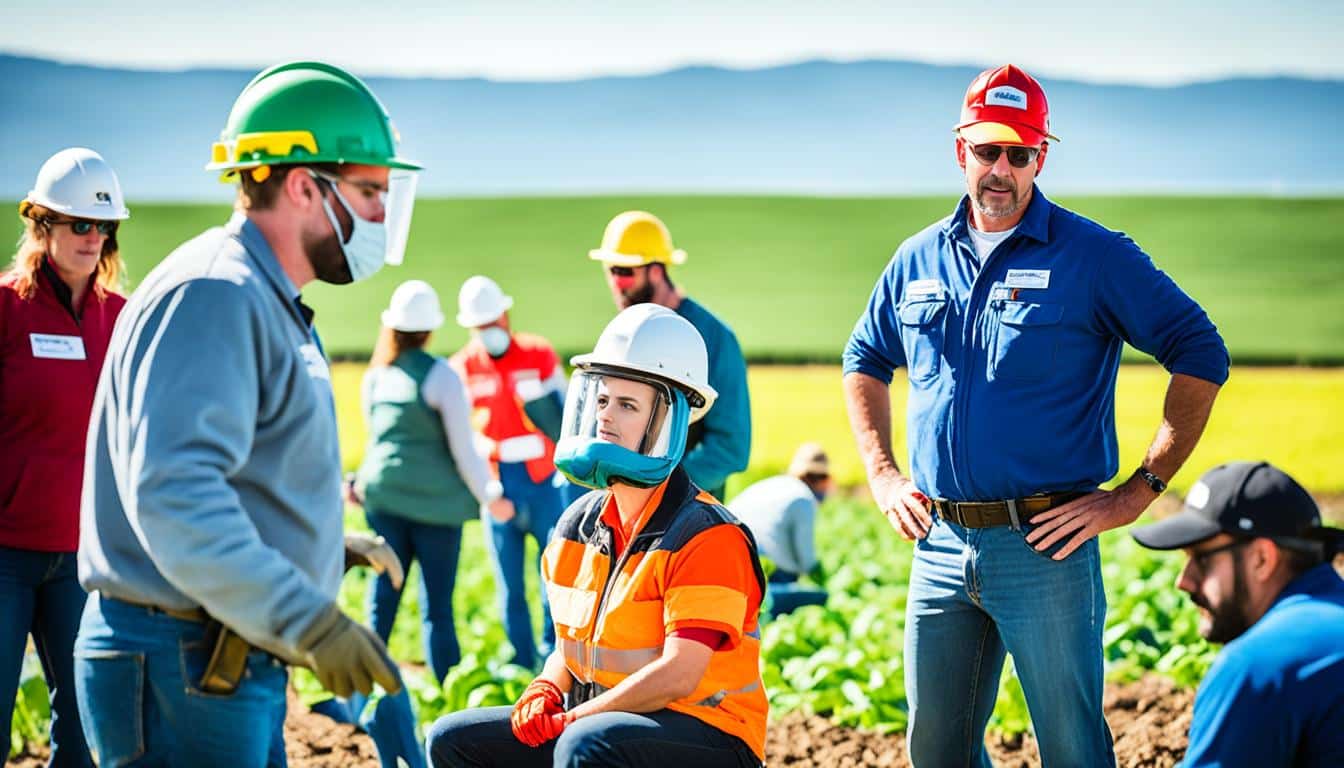
Did you know that 76 percent of local governments tackled a major disaster in the past 15 years? This means teaching farm workers how to respond to emergencies is crucial. It ensures they can handle sudden threats and keep both themselves and operations safe.
The health and safety of farm workers very much depend on being ready to face emergency situations. In New York, NYCAMH offers vital safety support to farms, often free of charge. They identify risks through On-Farm Safety Surveys and provide safety training in English and Spanish.
It’s crucial for farms to have a plan for when emergencies strike. This plan should involve everyone, from the employers to the workers. With a good plan, everyone knows what to do, and this can reduce harm and damage.
Training farm workers for emergencies must cover various scenarios. They need to know how to get out safely, provide first aid, and stay alert. The Farm Emergency Response Program and hazard awareness training by NYCAMH are key for this.
Learning about farm worker safety training is vital. It helps workers deal with different emergencies. These can come from nature or by human actions. For example, nature might bring tornadoes, wildfires, or severe storms. While man-made problems could be fires, chemical spills, or accidents with animals.
Being ready for emergencies is much more than rules. It’s a deep commitment to safety. It all starts with making an Emergency Action Plan (EAP). With a good EAP, chaos is less likely and everyone can stay safer.
Training workers fully means they learn everything about emergencies. This includes how to evacuate, what alarms mean, and when to report an emergency. They should know how to do First Aid too.
Adding first responders to the training is also important. They get to know the farm and its dangers. That way, everyone can react fast and well in an emergency.
With the right farm safety and emergency response training, danger to workers is less. And the farm keeps running smoothly. It’s all about being ready for any kind of emergency, and keeping safety first at all times.
| Type of Emergency | Preparation and Response |
|---|---|
| Natural Emergencies | Develop clear evacuation protocols, conduct regular drills, and provide appropriate emergency equipment and first aid training. |
| Man-Made Emergencies | Ensure chemical handling procedures are followed, maintain equipment safely, and train workers in response protocols and first aid. Collaborate with first responders for simulations. |
Making a good Emergency Action Plan (EAP) is key to keeping farmworkers safe and the work going. It needs to cover every possible emergency, like tornadoes and chemical spills. This plan makes sure everyone knows what to do, saving lives and reducing damage.
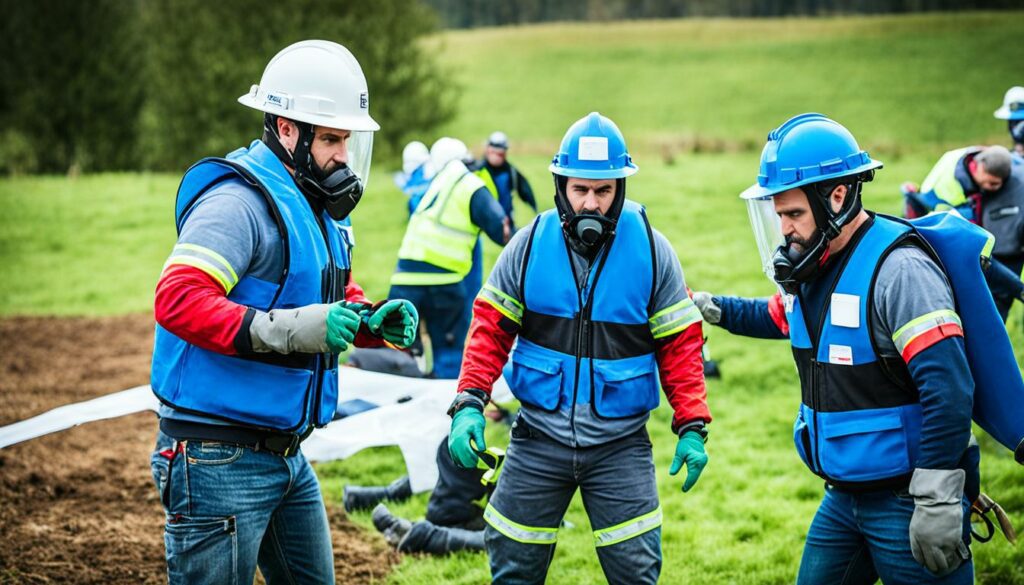
The plan should have clear paths to safely get away, ways to check everyone is okay, and how to get and give first aid. This makes the response smooth and prevents confusion.
Knowing how to talk with each other in a crisis is very important. Workers must know how to tell about an emergency and who to call for help. The plan should list all important contacts, like the local experts and suppliers. Doctors for the farm animals should also be in the list. Refreshing and practising the plan keeps it useful and updated against new dangers.
The EAP should help both bosses and workers work together well, showing what each should do. It lays out jobs such as turning off utilities and giving first aid. Including emergency teams in making the plan improves the farm’s readiness. They share their knowledge and can help a lot in a bad situation.
Regular practice and training ensure everyone knows the plan and feels ready to act. This makes the response quick and smooth when it’s for real. Doing drills with the workers each year finds any weak spots in the plan and makes sure everyone stays ready.
Checking and updating farm insurance often is another must-do. This makes sure the farm is covered for all emergencies and workers are protected. By making the EAP better all the time, farms can cut down the risks and keep their workers safe.
Agricultural emergencies can greatly affect farm work, safety, and success. They mainly fall into two groups: natural and man-made. Knowing about these emergencies is vital for first aid training in the countryside. Each emergency type needs its own approach and preparation. This makes sure workers are ready to act well and reduce risks.
Natural emergencies involve things like the weather and the environment. This includes things like tornadoes, hurricanes, and floods. Every event brings its own challenges. Workers must be trained to deal with these. For example, tornadoes mean quickly moving to safe spots. In the case of floods, knowing about ground rescue and safe exits is crucial.
Man-made emergencies in farming come from human actions and industry. They include spills, violence, and machinery mishaps. Addressing these needs a good grasp of safety rules and first aid measures. With the right training, workers can safely manage spills, calm down fights, and help with machinery accidents.
| Type of Emergency | Examples | Response Training Focus |
|---|---|---|
| Natural | Tornadoes, Hurricanes, Wildfires, Floods, Severe Storms | Evacuation procedures, water rescue, shelter-in-place strategies |
| Man-Made | Chemical Spills, Workplace Violence, Machinery Accidents | Hazardous material handling, conflict resolution, first aid skills |
Training for rural emergencies should cover both natural and man-made incidents. This rounded training helps workers deal with a variety of dangers. It makes farming environments safer and more able to bounce back from emergency situations.
Working closely with first responders is key to a farming safety plan’s success. They need to know the farm’s layout, what dangers are there, and how the equipment works. This info helps them respond quickly in an emergency, keeping everyone safe.
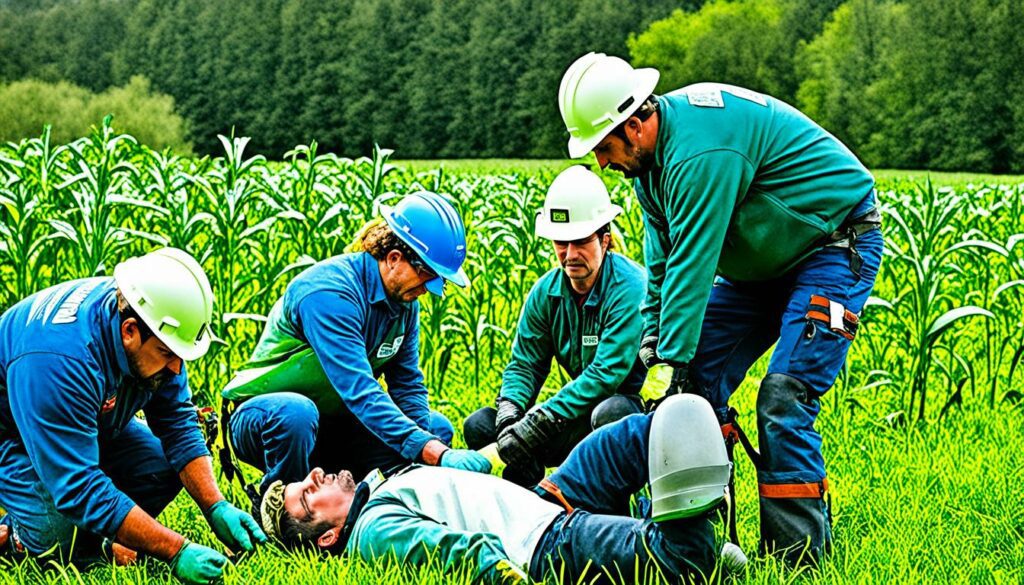
| Aspect | Detail |
|---|---|
| Participating Individuals | First Responders, Farm Workers, Contractors |
| Types of Emergencies | Natural, Man-Made |
| Training Elements | Evacuation Plans, Alarm Systems, First Aid, Chemical Spill Control |
| Frequency of Drills | Annually or As Needed |
| Emergency Resources | Site Maps, Safety Checklists, Emergency Contact Lists |
It’s also vital to tell contractors about their work’s unique dangers. Including local responders in training boosts readiness. It creates a united, effective response to any crisis. A proactive stance readies everyone for the unexpected.
Designing a great evacuation plan demands thinking about what both team members and the farm need. A good plan saves lives and cuts down on harm during emergencies. It’s worrisome that over 85% of businesses without a strong emergency plan close up within two years. This shows how crucial a solid evacuation plan is.
Everyone at the farm must know how to leave quickly and where to meet. Roughly 60% of farms do not have a detailed plan, making it vital to make one. We should also note that people often take about 1 hour to react to emergencies, so having practiced plans helps with quick and safe evacuations.
Sometimes, leaving is not an option, so it’s key to have safe spaces at the farm. These places need to have food, medicine, and other supplies, which are very important in handling around 40% of emergencies well. Yet, only 30% of farms have set up how to care for animals during these times. This shows there’s room to do better. Teaching the team about using these shelters forms a big part of their emergency training.
Less than 25% of farms have clear instructions on using key machines during a crisis. Regularly rehearsing these procedures is essential. For instance, evacuation drills help refine how we respond when real emergencies happen. This, combined with thorough *agricultural emergency response training*, readies the team for diverse challenges, from chemical accidents to fires and extreme weather.
In summary, clear escape routes, well-equipped shelter zones, and trained workers are vital for readiness. These steps in a good evacuation plan protect people and keep the farm going strong in hard times.
Training farm workers on safety is essential. They face all sorts of dangers from nature and industry. With different kinds of disasters possible, like tornadoes and fires, having a good emergency plan is a must.
Every farm should have an Emergency Action Plan (EAP). It should include what to do in an emergency, who does what, and how to call for help. Workers and families should help make the plan. This way, every potential problem is covered.
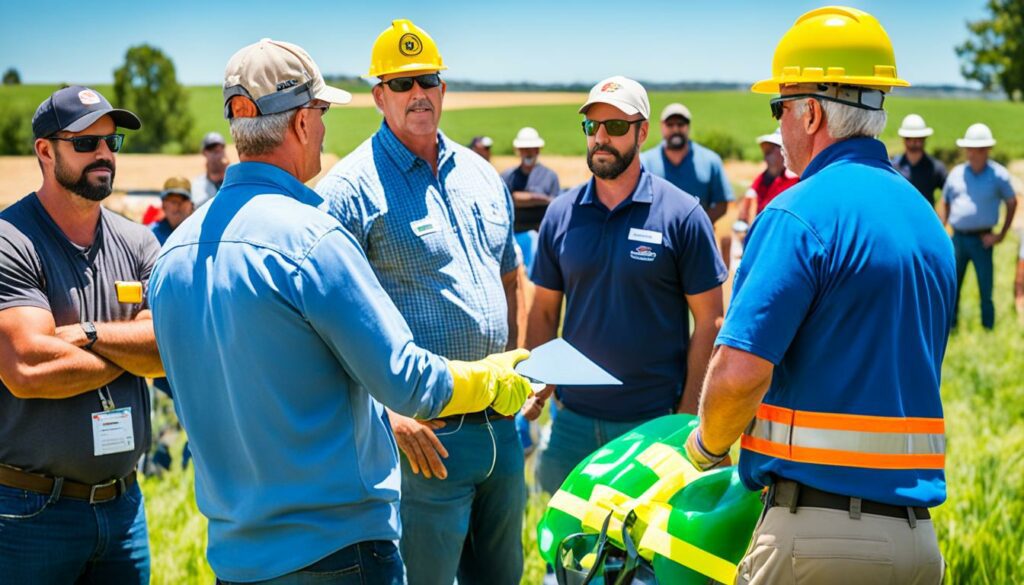
First responders need to know the layout of the farm and the risks there. Meeting with local emergency services before anything happens is smart. This helps them know the farm better and be ready to help fast. It works together with safety training to protect workers.
All workers should know how to leave the farm if there’s an emergency, what an alarm means, and what to do in a drill. This kind of training is critical. Doing it often keeps everyone ready to handle an emergency. This keeps the farm safe.
| Emergency Type | Frequency | Training Focus |
|---|---|---|
| Natural Disasters (e.g., Tornadoes, Hurricanes) | Annually | Evacuation Routes, Shelter-in-Place |
| Chemical Spills | As needed | Spill Control, First Aid |
| Animal Handling Incidents | Monthly | Safe Animal Handling, Emergency Contact Procedures |
| Power Failures | Semi-Annually | Backup Systems, Equipment Shutdown |
Having a well-trained emergency response team is key. They know how to use fire extinguishers, do CPR, and save people. This keeps emergencies under control. Also, make sure even the people who come to fix things know about any risks on the farm.
By teaching workers well and having a good plan, the farm is safer for everyone. Ready workers and a strong plan lower the chances of a bad accident. Everyone on the farm benefits from this safety work.
First aid training is a must for agricultural workers. It’s vital for saving lives. With training, workers can act fast until help from professionals comes. This is key on farms where help can be far away.
These workers learn basic first aid. They can deal with cuts, burns, fractures, and heat stress. They also know how to handle chemical burns from farming chemicals. Knowing these skills cuts down on how serious injuries can be.
CPR is critical for farm workers’ first aid training. It’s what you do to help someone breathe and circulate blood when their heart stops. Because farms can be far from hospitals, knowing CPR is a must-have. The Agriculture First Aid & CPR Online Training is a very useful resource with a top rating. It makes sure workers know how to do CPR well.
The training also meets health and safety requirements under the law. This makes sure workers are ready for emergencies. It’s a big deal for farm safety.
Effective communication during emergencies is vital for quick, coordinated safety actions. Reliable equipment ensures everyone knows the situation and how to proceed. This helps keep the farm safe.

Two-way radios are key for quick responses on the farm. They connect workers and first responders instantly, aiding swift reactions. These radios help with evacuations, coordinate rescues, and share real-time updates.
Public address (PA) systems are vital for large emergencies on the farm. They make sure all workers hear important announcements. PA systems follow safety protocols well, giving clear instructions when needed most.
Doing farm exercises and drills is key for farm staff to react in emergencies. By regularly doing drills, farms make sure their plans are strong and work for various situations. These can be caused by nature or by people.
Farm drills should happen often to keep everyone ready. It’s best to do them at least once a year. These drills make sure everyone knows what to do when there’s a real emergency.
Practising the steps to follow helps workers to act quickly and well in emergency situations.
After drills, it’s important to review how things went. This means checking how well everyone did and seeing what was good and what needs work. By looking at what happened in detail, farms can make their plans better.
This helps keep emergency training up to date and improve how workers respond in future.
Here is a detailed outline of the key elements and recommendations for conducting effective farm exercises and drills:
| Key Elements | Recommendations |
|---|---|
| Frequency of Drills | Conduct drills at least once annually to ensure preparedness. |
| Scope of Drills | Cover a range of scenarios, including natural and man-made emergencies. |
| Worker Participation | Ensure all farm workers are involved in the drills to test communication and coordination. |
| Evaluation Criteria | Establish clear criteria to assess the effectiveness of drills. |
| Post-Drill Reviews | Conduct post-drill reviews to identify areas for improvement and refine the Emergency Action Plan. |
Good training for emergencies is key in agricultural safety training programs. Workers learn about evacuations, alarms, how to report, and more. Employers should check the Emergency Action Plan (EAP) when certain events happen.
Training must be clear for all workers, in a language they all understand. This helps everyone know what to do during emergencies. This could be a natural event or an accident.
Practising with emergency drills is very important. They ensure everyone knows their role under pressure. Workers on the emergency team need special training. They should know how to use fire extinguishers and give first aid.
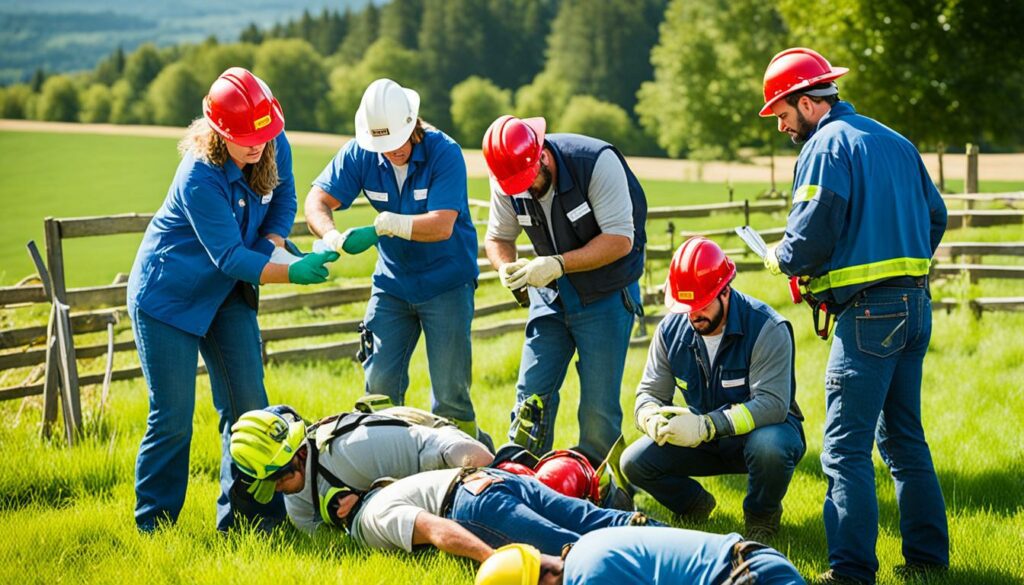
Workers should always get the right information and training. This keeps them safe and helps the farm stay strong. Employers can set up ways to be more ready, like having a contact list and extra safety gear around. This can help during emergencies.
By preparing well, agricultural safety training programs follow what local governments advise. Most places have dealt with large disasters in recent years. Being ready helps protect the farm and its people.
Having clear roles and responsibilities in an Emergency Action Plan (EAP) is very important on a farm. It helps make sure everyone knows what to do quickly and well in emergencies. This is key for emergency procedures to work properly.
Employers are vital in setting up and looking after emergency procedures for farm workers. They must do several things:
Doing these tasks can cut down on mistakes, injuries, and harm to farm property when there’s an emergency.
Workers also play a big part in making sure the EAP runs well. They must:
All workers should be trained in a language they understand. This is to make sure everyone knows what to do and what dangers to look out for, as set out by OSHA rules.
If you need more help, check the emergency preparedness guide. It gives a lot of detail on how to plan and put into action good emergency procedures for farm workers.
Keeping accurate notes on farm stock is vital for handling emergencies well. This is key for training in case of farm emergencies. It helps run things smoothly and effectively when trouble hits.
Keeping good records of your farm tools, where they are, and what they are, helps a lot during an emergency. It lets you know what to save first and what to shut down. This speeds up the rescue process and keeps things under control.
| Component | Details |
|---|---|
| Location | Identify where each piece of machinery is situated |
| Make and Model | Record the make and model number for all machinery |
| Operation Protocols | Document shutdown and maintenance procedures |
| Maintenance Records | Keep up-to-date logs of each piece of equipment |
It’s just as important to know where all your animals are on the farm. This helps the emergency teams to evacuate or help them quickly and in order during a crisis.
| Component | Details |
|---|---|
| Livestock Locations | Map out where livestock are housed |
| Quantity | Count the number of animals in each location |
| Emergency Contacts | List next-of-kin and other essential contacts |
| Health Records | Maintain up-to-date medical records for livestock |
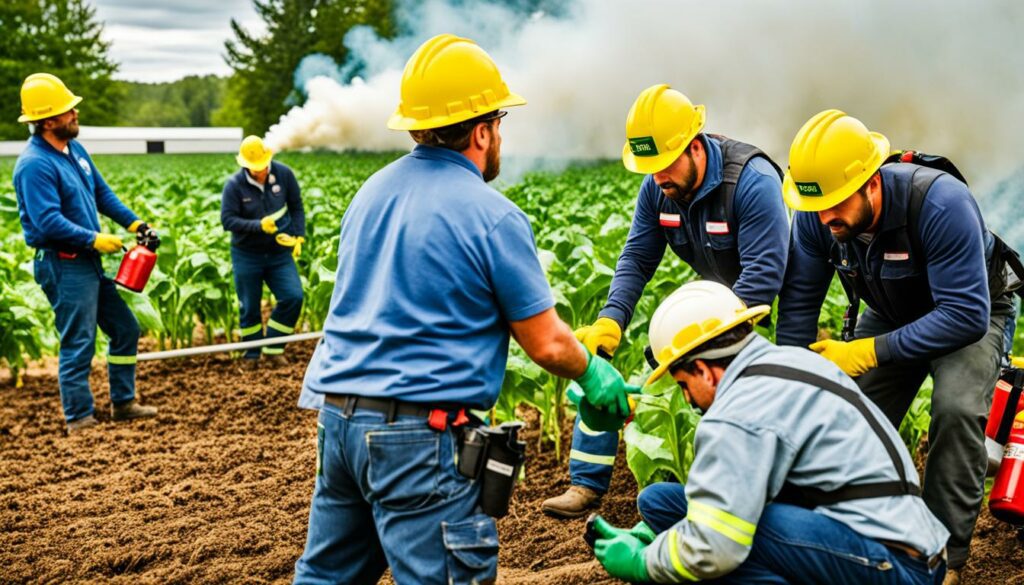
To deal with emergencies, make sure your emergency plans have all this information. This way, farm owners can handle any crisis, protecting people and animals.
Teaching farm workers about emergency response is crucial. It’s more than just following rules – it’s about keeping people safe and ready for anything. Training should be detailed, ongoing, and focus on what each farm needs specifically. This way, workers gain the knowledge and skills they need to reduce risks in their jobs.
In emergency response training, many different situations are covered. For instance, a programme by the Army Corps of Engineers looks at dealing with floods and how to recover after. This is especially helpful for farms in flood areas. Programs like Appalachia’s POWER help workers bounce back after disasters, tackling economic struggles.
Adapting training to suit different farm workers is key. Most US farm workers are from Mexico and speak Spanish. So, the training should be in Spanish to make sure everyone understands and can take part.
These workers often face tough financial situations and may not have had much education. So, easy-to-access training is vital. By focusing on continuous, inclusive training, we make their work safer. This helps them deal well with emergencies on the farm.
Farm workers must have safety training. This makes sure they are skilled and safe. It also protects their rights. The Agricultural Workforce Services Program helps both workers and employers in Colorado. It has an online resource hub to teach workers about their labour rights.
Workers should know their safety rights. Many rules come from OSHA and NIOSH. They say workers should have a safe place to work. Workers must get to see safety records. And, they can report problems without getting into trouble. Knowing your rights is just as important as knowing what to do in an emergency.
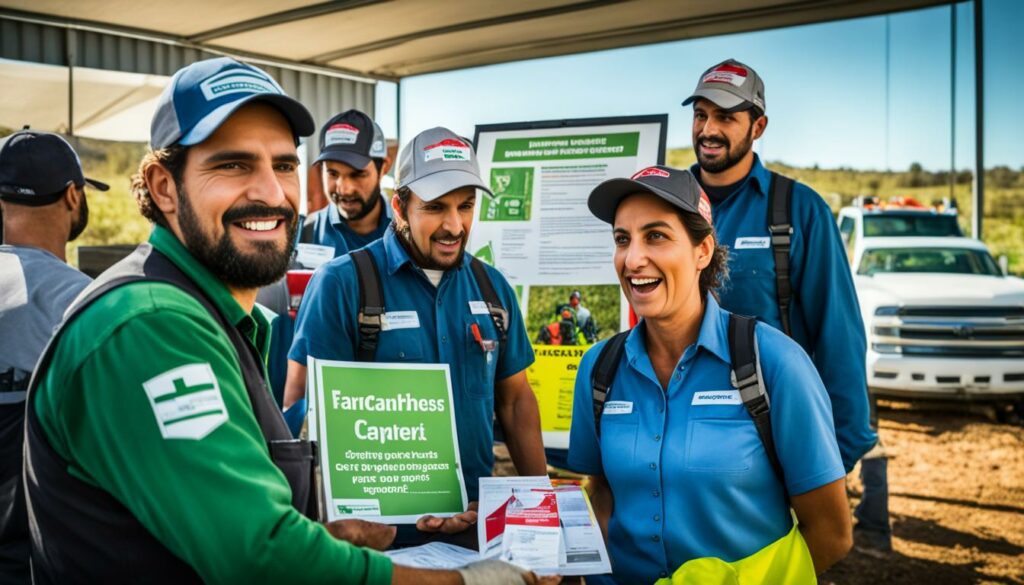
There are lots of resources to help with health, safety, and work problems. Training programs meet the needs of workers and employers. The High School Equivalency Program helps workers further their education. Partnerships with places like MSU Denver and Colorado State University-Pueblo aim to educate workers. This is because informed workers are safer workers.
Safety also means taking care of health. Community Health Centers and the Colorado Agricultural Addiction and Mental Health Program give support. Employment services help with things like unemployment and finding a place to live. These services are key in keeping workers well.
The Occupational Safety and Health Act says workplaces should be safe. Employers must make sure workers understand safety training. They also need to keep safety records available. It’s crucial to have a plan for hot weather. This includes how to spot heat sickness and what to do about it. Making sure workers get medical help quickly is part of this, too.
Emergency response teams are crucial for farm safety. They play a key role in preparing for and dealing with emergencies. Whether formed internally or working with other groups, they are trained for firefighting, first aid, chemical spills, and rescues. They act fast during emergencies and get ready for more help to arrive.
These teams receive top-notch training from well-known groups like St John Ambulance, the Australian Red Cross, and more. Members learn how to respond to a wide range of emergencies, from natural disasters to accidents with machinery.
Farmers should make sure more than one worker knows how to act in emergencies. This sharing of knowledge boosts the team’s ability to handle incidents and save lives.
It’s also key to have the right ways to talk to each other. Gadgets like two-way radios and mobile phones are vital for good communication. Plus, it’s important for the farm to have plans for different emergencies, such as fires or floods. This makes sure everyone knows what to do when something goes wrong.
There are also special training programmes available for emergency teams. For instance, the PA Agricultural Rescue Training teaches them how to deal with hazards like machinery and chemicals. This training helps fire, EMS, and CART crews become more skilled in protecting farms and those who work on them.
To sum up, having well-trained emergency teams on farms ensures quick and effective emergency responses. This not only protects the farm but also the people on it.
Emergency response training for farm workers is key. It highlights safety and readiness. This training is vital for keeping agricultural workers safe in emergencies. It mixes learning from books and actual practice. This way, workers learn how to deal with different crises.
The best way for workers to learn is by doing. They remember little by just hearing or seeing things. Yet, when they talk about and do tasks, their memory skyrockets. This shows why demo sessions and one-to-one training work best.
Online courses are helpful but not always enough for big farms. Including train-the-trainer classes can make a big difference. The goal is to have training that fits different languages and needs, making it fun and efficient. This ensures farm workers both learn well and enjoy their training.
Always improving Emergency Action Plans is a continuous task. It shows how much we care about farm worker safety and the farm industry’s future. Making training easier to understand and helping farm bosses become better trainers is also important. It’s about working together to be ready and safe on farms.
This training teaches farm workers how to deal with different kinds of emergencies. They learn how to stay safe and be ready for anything. This includes natural disasters and accidents caused by people.
It’s vital because it helps workers handle emergencies well. This training aims to lower the chance of people getting hurt or things getting damaged. It’s all about creating a safe place to work and following the law.
A good EAP has ways out in an emergency and lists everyone’s job. It also says who helps with rescue and medical care. Plus, it explains how to tell others about an emergency. Everyone must practice the plan to make sure it works.
Farm emergencies can be from nature like storms or man-made like spills. They also include things like workplace violence and accidents with machinery. Being ready for all these helps keep everyone safe.
Working with local emergency teams means they know the farm well. They learn about dangerous things on the farm and how things are laid out. This helps make their help quicker and better in a crisis.
A good evacuation plan tells everyone how to get out and where to meet. It shows the safest paths and where to go if you can’t leave. Practising the plan helps make sure it works when it’s not a drill.
Safety rules cover using machines carefully and handling chemicals safely. In an emergency, knowing what to do is crucial. Clear steps help stop accidents and make sure everyone responds together.
First aid lessons cover basic care like CPR. They teach workers how to help until a doctor gets there, which is extra important in remote areas.
Two-way radios and loudspeakers are key for quick talk during a crisis. They make it possible for everyone to hear important messages instantly.
Farms should test their plans often, making them better each time. Talking about what worked and what didn’t after a drill is key to being more prepared.
Teaching workers about emergencies includes making sure everyone knows the plans and how to tell others about a problem. It’s important that everyone understands their role clearly.
Bosses have to make a good EAP and make sure everyone knows what to do. Workers need to follow the plan properly, which includes knowing how to get out safely and when to help close up.
Making a list of all the machines and animals helps in an emergency. It lets people know what needs the most help first. This makes the response to an emergency go smoother.
Workers need to learn a lot and keep learning to stay safe on the farm. They learn the rules and how to put them into practice to stop accidents.
Farm workers have the right to work in a safe place and get taught in a way they understand. They can check on safety records and speak up without fear. Knowing these rights is part of their safety training.
Teams ready to act fast help stop an emergency from getting worse. They know what they need to do, like fight fires or help people. They also get things ready for more help to come.